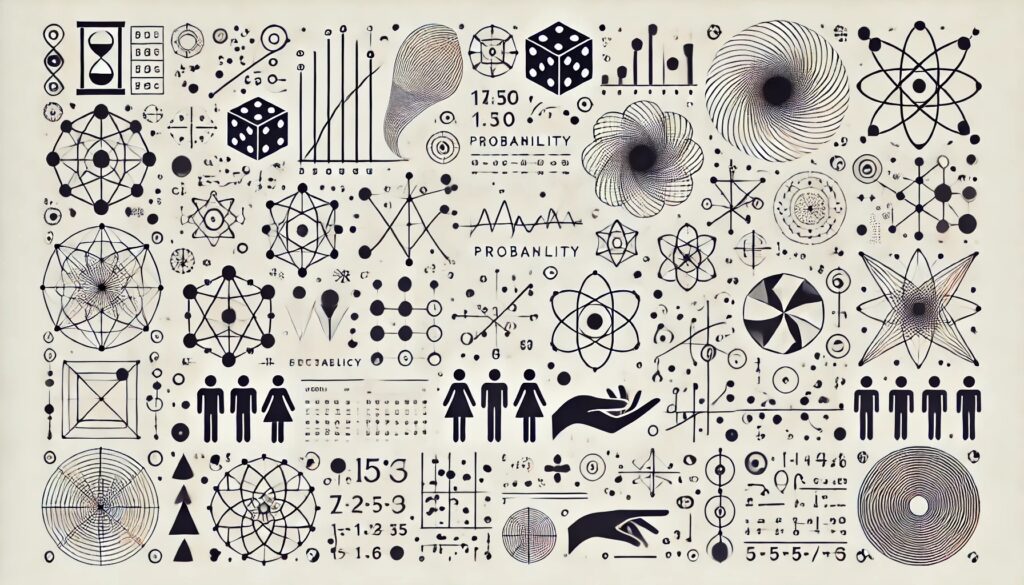
ChatGPT:
Strength in Numbers: Discover the Joy and Power of Mathematics in Everyday Life – Extended Summary
In Strength in Numbers, Sherman K. Stein provides a vivid and engaging exploration of how mathematics permeates nearly every facet of life, art, and science. The book is designed to make math approachable and enjoyable, even for those who may not consider themselves mathematically inclined. It highlights the beauty and utility of mathematical principles, drawing connections between abstract mathematical concepts and real-world applications, demonstrating how math enhances our understanding of the universe and everyday life.
Stein delves into a wide array of topics—from geometry and probability to mathematical patterns in nature—while keeping his explanations clear and relatable. Each chapter presents a new lens through which readers can view the practical and aesthetic roles of mathematics.
🧠 Chapter-by-Chapter Breakdown 🧠
1. Geometry’s Hidden Influence
The first chapter explores how geometry plays an essential role in architecture, design, and even natural formations. Stein begins by discussing the use of geometric shapes in the construction of buildings throughout history, such as the pyramids of Egypt and modern skyscrapers. The precise use of angles, symmetry, and proportions in architecture is not just a matter of aesthetics but also practicality, ensuring the stability and longevity of structures. The chapter also covers geometry in everyday objects, such as the shape of a smartphone or a kitchen table, explaining how these designs maximize utility and ergonomics.
Stein also touches on how geometry underpins much of nature’s beauty—such as the perfect hexagonal structure of honeycombs and the radial symmetry of flowers. Geometry is shown to be a common thread connecting the human-made and natural worlds.
2. The Power of Probability in Life
In this chapter, Stein delves into probability theory and its profound influence on everyday decisions. He illustrates how probability is used to calculate risks and make predictions, from weather forecasts to insurance premiums and even medical diagnoses. The concept of expected value is explained in simple terms, showing readers how they can use it to make informed decisions in uncertain situations. For instance, the discussion includes how casinos use probability to design games in their favor and how individuals can use basic probability to weigh the risks and rewards of everyday choices, such as buying a lottery ticket or deciding whether to invest in the stock market.
Stein also highlights the less obvious ways probability impacts us, such as the spread of diseases, political polling, and even artificial intelligence algorithms. Probability emerges as a tool for navigating uncertainty, offering insights into how likely certain events are to occur.
3. Mathematics and the Arts
Stein shifts the focus from practical applications to the aesthetic side of mathematics, showing how math is intricately connected to the arts. He explores the use of proportions, symmetry, and ratios in visual art, particularly in works by Renaissance artists like Leonardo da Vinci. The Golden Ratio—a famous mathematical proportion—is shown to appear in countless works of art, architecture, and even in nature, such as the spiral of a nautilus shell.
Music is another domain where math shines, as Stein explains how mathematical patterns, frequencies, and rhythms are at the core of musical composition. The structure of musical scales, harmonics, and timing are all rooted in mathematics. Similarly, literature, especially poetry, is discussed in terms of the rhythms and structures that follow mathematical patterns, such as the iambic pentameter in Shakespearean sonnets.
4. Making Decisions with Math
This chapter presents practical examples of how math can help with decision-making in everyday life. Whether calculating interest on a loan, comparing prices while shopping, or planning a budget, mathematics provides the tools necessary to make smarter financial decisions. Stein explains basic concepts like percentages, compounding interest, and unit pricing in simple terms, showing how these concepts can be applied to real-life situations.
He also touches on the mathematics of health and fitness, explaining how calorie counting, exercise plans, and nutritional choices can be optimized through math. This chapter emphasizes the idea that mathematical thinking is not only for complex problems but also for mundane decisions that can have a significant impact on one’s life.
5. Mathematics in Nature
Stein discusses the omnipresence of mathematics in the natural world. From the Fibonacci sequence, which appears in the arrangement of leaves on a stem, to the symmetry of snowflakes, mathematics can be seen in various natural phenomena. The chapter explains how fractals—complex geometric shapes—are found in natural structures such as mountain ranges, coastlines, and clouds. These patterns are self-similar, meaning they appear similar at different scales, and they provide insights into the complexity and efficiency of nature’s designs.
Stein also touches on biological growth, showing how mathematical models can describe the rate at which populations grow or how cells divide. The relationship between math and the natural world deepens our understanding of the underlying order in seemingly chaotic systems.
6. Games of Chance: The Mathematics Behind Fun
This chapter delves into the mathematical principles that govern games of chance and strategy, such as poker, roulette, and chess. Stein explains how probability and combinatorics—the study of counting—are used to analyze these games, making them not only entertaining but intellectually stimulating. He discusses how understanding the odds in a game can drastically improve a player’s strategy and decision-making process.
Through these examples, Stein conveys that math is not only practical but also fun, offering opportunities to apply mathematical thinking in recreational activities. The chapter also touches on the paradoxes and puzzles in mathematics, showing that some mathematical problems can be both mind-boggling and delightful to solve.
7. Data, Statistics, and Society
In the modern world, data and statistics are everywhere, from politics and economics to health and sports. Stein covers the importance of being statistically literate in order to navigate the overwhelming amount of data presented to us in the news, online, and in daily conversations. He explains concepts like averages, distributions, and outliers, using relatable examples such as sports statistics or opinion polls.
The chapter also warns of the misuse of statistics, demonstrating how data can be manipulated to mislead people. Stein provides readers with tools to critically evaluate the data they encounter, encouraging skepticism and thoughtful analysis.
8. Number Theory for the Curious
This chapter provides an introduction to number theory, the branch of mathematics concerned with the properties of numbers, particularly integers. Stein presents number theory in a fun and accessible way, discussing prime numbers, divisibility, and famous conjectures like Fermat’s Last Theorem. He shares interesting trivia, such as the use of prime numbers in cryptography and their importance in securing digital communications.
This section is a reminder that math can be intriguing and intellectually stimulating, not just a tool for practical problems. Stein’s approach makes even complex topics like number theory engaging for readers with varying levels of math experience.
9. The History of Collaboration in Mathematics
This chapter takes a step back to explore the collaborative nature of mathematical discovery. Stein highlights how great mathematicians like Euclid, Newton, and Euler built on the work of their predecessors, showing that math is not just the product of individual genius but of collective effort. This collaboration across centuries has led to the vast and interconnected body of mathematical knowledge we have today.
Stein also emphasizes the role of teamwork in contemporary mathematical research, particularly in fields like applied mathematics and computer science, where groups of mathematicians and scientists often work together to solve complex problems.
10. Math is for Everyone
In the final chapter, Stein reinforces his central thesis that math is not only for mathematicians or scientists but for everyone. He argues that understanding even basic mathematical principles can enrich one’s life, enhancing decision-making, creativity, and problem-solving skills. Stein encourages readers to embrace math as a way to engage more deeply with the world around them, finding beauty and utility in numbers, patterns, and logic.
He closes with the hopeful message that math can be a source of joy and empowerment for anyone willing to explore it.
Takeaways
- Geometry is essential in both human-made structures and natural phenomena.
- Probability and statistics help us make informed decisions in uncertain situations.
- Mathematics enriches art, music, and literature by providing structure and beauty.
- Mathematical thinking can improve everyday decision-making, from finances to health.
- Math is present in nature, from the patterns in flowers to the structure of galaxies.
- Games of chance and strategy are governed by mathematical principles, making them intellectually engaging.
- Statistical literacy is crucial in the modern world to interpret data and avoid being misled.
- Number theory offers fascinating insights into the properties of integers and has practical applications in cryptography.
- Collaboration in mathematics has been a key driver of major discoveries throughout history.
- Math is for everyone, and understanding it can enhance both practical and intellectual aspects of life.
FAQs on Strength in Numbers: Discover the Joy and Power of Mathematics in Everyday Life by Sherman K. Stein
Q: What is the main goal of Strength in Numbers?
A: The main goal of the book is to demonstrate how mathematics is deeply integrated into everyday life and to show that math is not only a practical tool but also a source of beauty and enjoyment. Sherman K. Stein aims to make math accessible and interesting, even for readers without a strong mathematical background.
Q: Who is the book intended for?
A: The book is intended for a broad audience, including both math enthusiasts and those who may feel intimidated by the subject. Stein writes in a clear and engaging style, making complex concepts easy to understand for readers at all levels.
Q: How does the book relate math to everyday life?
A: The book illustrates how math affects various aspects of daily life, such as decision-making, art, nature, and even entertainment. Examples include geometry in architecture, probability in weather forecasting, and mathematical patterns in nature.
Q: Does the book cover advanced mathematical topics?
A: While the book introduces some advanced topics, such as number theory and prime numbers, Stein explains them in a way that is accessible to readers without a deep mathematical background. The focus is on making math relatable and enjoyable rather than overly technical.
Q: What are some examples of math in nature discussed in the book?
A: The book explores how mathematical patterns appear in nature, such as the Fibonacci sequence in the arrangement of leaves and flowers, fractals in coastlines and clouds, and symmetry in snowflakes and honeycombs.
Q: How does Stein explain the connection between math and art?
A: Stein shows how mathematical principles like the Golden Ratio, symmetry, and proportions influence visual arts, music, and literature. For example, he explains how mathematical rhythms are at the core of musical composition and how proportions shape Renaissance art.
Q: How does the book explain probability and its uses in everyday decisions?
A: Probability theory is discussed in the context of risk assessment and decision-making, such as calculating insurance premiums, gambling odds, and making predictions in uncertain situations like weather forecasts.
Q: What is the significance of number theory in the book?
A: Stein introduces number theory as an engaging and intellectually stimulating part of mathematics, discussing the importance of prime numbers, their role in cryptography, and the fun behind puzzles and number sequences.
Q: How does the book address the collaboration in mathematical discoveries?
A: The book highlights the historical and ongoing collaboration among mathematicians. It explains how major discoveries are often the result of collective efforts, building upon the work of previous generations of scholars.
Q: What message does the book leave readers with regarding the role of mathematics?
A: The book concludes with the idea that mathematics is for everyone, not just for professionals. Understanding even basic mathematical concepts can enhance one’s daily life and provide both practical benefits and intellectual enjoyment.

